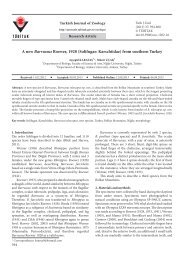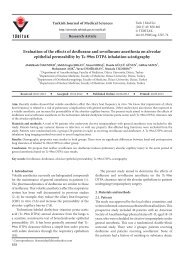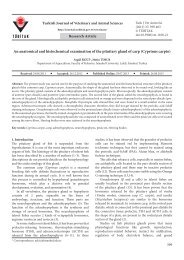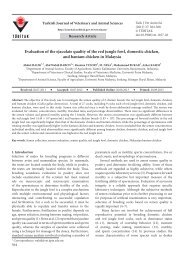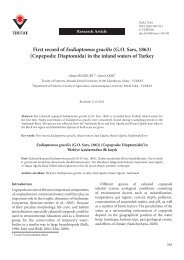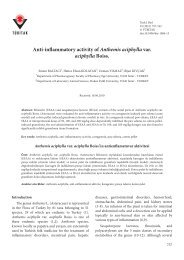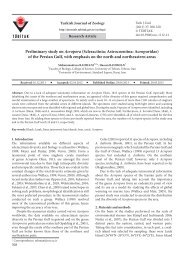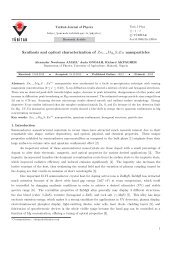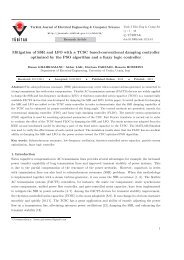The effect of ovine placenta extract on mammogenesis, lactogenesis ...
The effect of ovine placenta extract on mammogenesis, lactogenesis ...
The effect of ovine placenta extract on mammogenesis, lactogenesis ...
Create successful ePaper yourself
Turn your PDF publications into a flip-book with our unique Google optimized e-Paper software.
Research Article<br />
Th e eff ect <str<strong>on</strong>g>of</str<strong>on</strong>g> <str<strong>on</strong>g>ovine</str<strong>on</strong>g> <str<strong>on</strong>g>placenta</str<strong>on</strong>g> <str<strong>on</strong>g>extract</str<strong>on</strong>g> <strong>on</strong> <strong>mammogenesis</strong>,<br />
<strong>lactogenesis</strong>, and galactopoiesis in sheep<br />
Gabriel COTOR*, Aneta POP, Marian GHITA<br />
Department <str<strong>on</strong>g>of</str<strong>on</strong>g> Physiology, Th e Faculty <str<strong>on</strong>g>of</str<strong>on</strong>g> Veterinary Medicine, Bucharest - ROMANIA<br />
Received: 16.10.2006<br />
G. COTOR, A. POP, M. GHITA<br />
Turk. J. Vet. Anim. Sci.<br />
2011; 35(3): 137-142<br />
© TÜBİTAK<br />
doi:10.3906/vet-0610-34<br />
Abstract: Th e aim <str<strong>on</strong>g>of</str<strong>on</strong>g> the present study was to evaluate the eff ect <str<strong>on</strong>g>of</str<strong>on</strong>g> <str<strong>on</strong>g>ovine</str<strong>on</strong>g> <str<strong>on</strong>g>placenta</str<strong>on</strong>g> <str<strong>on</strong>g>extract</str<strong>on</strong>g>, obtained by affi nity<br />
chromatography <strong>on</strong> immobilized wheat germ lectin, <strong>on</strong> <strong>mammogenesis</strong>, <strong>lactogenesis</strong>, and galactopoiesis in pregnant<br />
and lactating sheep. Placental <str<strong>on</strong>g>extract</str<strong>on</strong>g> (100 μg/mL protein c<strong>on</strong>centrati<strong>on</strong>) was subcutaneously injected to pregnant sheep<br />
in days 1, 4, 7, 10, and 13 <str<strong>on</strong>g>of</str<strong>on</strong>g> the experiment (totally 10 mL <str<strong>on</strong>g>placenta</str<strong>on</strong>g> <str<strong>on</strong>g>extract</str<strong>on</strong>g>/animal) alternatively <strong>on</strong> the right and left<br />
side <str<strong>on</strong>g>of</str<strong>on</strong>g> the neck. Placental <str<strong>on</strong>g>extract</str<strong>on</strong>g> induced a more intense development <str<strong>on</strong>g>of</str<strong>on</strong>g> udder parameters; udder circumference<br />
increase was <str<strong>on</strong>g>of</str<strong>on</strong>g> 16.73%, anteroposterior length increase was <str<strong>on</strong>g>of</str<strong>on</strong>g> 15.9%, and latero-lateral length <str<strong>on</strong>g>of</str<strong>on</strong>g> 11.1%. Placental<br />
<str<strong>on</strong>g>extract</str<strong>on</strong>g> administrati<strong>on</strong> resulted in 7.92% increase in milk yield. Lactating ewes were m<strong>on</strong>itored for milk producti<strong>on</strong><br />
for 6 days before the experiment, aft er <str<strong>on</strong>g>placenta</str<strong>on</strong>g>l <str<strong>on</strong>g>extract</str<strong>on</strong>g> administrati<strong>on</strong> from day 7 to day 14 <str<strong>on</strong>g>of</str<strong>on</strong>g> the experiment, twice<br />
a day, and they presented 14.14% higher milk yield in comparis<strong>on</strong> with the c<strong>on</strong>trol group, no signifi cant diff erences<br />
in milk lactose and protein c<strong>on</strong>tent, but an increase in milk fat (6.2%). It may be c<strong>on</strong>cluded that the glycoprotein or<br />
glycopeptide isolated from sheep <str<strong>on</strong>g>placenta</str<strong>on</strong>g> by affi nity chromatography <strong>on</strong> wheat germ lectin increased <strong>mammogenesis</strong>,<br />
<strong>lactogenesis</strong>, and galactopoiesis in sheep.<br />
Key words: Ovine <str<strong>on</strong>g>placenta</str<strong>on</strong>g> <str<strong>on</strong>g>extract</str<strong>on</strong>g>, <strong>mammogenesis</strong>, <strong>lactogenesis</strong>, galactopoiesis<br />
Introducti<strong>on</strong><br />
Placenta’s endocrine functi<strong>on</strong>, during gestati<strong>on</strong>,<br />
is <strong>on</strong>e <str<strong>on</strong>g>of</str<strong>on</strong>g> the most important events that infl uence<br />
both the future <str<strong>on</strong>g>of</str<strong>on</strong>g> the newborn and the next lactati<strong>on</strong><br />
(1-4). Placental lactogen horm<strong>on</strong>e, <strong>on</strong>e <str<strong>on</strong>g>of</str<strong>on</strong>g> most<br />
important horm<strong>on</strong>es, was identifi ed in <str<strong>on</strong>g>placenta</str<strong>on</strong>g>s <str<strong>on</strong>g>of</str<strong>on</strong>g><br />
some domestic animals, such as cow and sheep, and<br />
also in human <str<strong>on</strong>g>placenta</str<strong>on</strong>g> (5,6).<br />
Placental lactogen horm<strong>on</strong>e was identifi ed in the<br />
blood <str<strong>on</strong>g>of</str<strong>on</strong>g> pregnant females, during the sec<strong>on</strong>d half<br />
<str<strong>on</strong>g>of</str<strong>on</strong>g> pregnancy; the climax <str<strong>on</strong>g>of</str<strong>on</strong>g> blood c<strong>on</strong>centrati<strong>on</strong><br />
being recorded simultaneously with the moment <str<strong>on</strong>g>of</str<strong>on</strong>g><br />
maximum intensity <str<strong>on</strong>g>of</str<strong>on</strong>g> <strong>mammogenesis</strong> (7,8). In ewes,<br />
the <str<strong>on</strong>g>placenta</str<strong>on</strong>g>l lactogen horm<strong>on</strong>e is represented by a<br />
* E-mail: cotorg@yahoo.com<br />
single polypeptide chain c<strong>on</strong>taining 198 residues,<br />
generated from 236-amino acid precursor, and is a<br />
member <str<strong>on</strong>g>of</str<strong>on</strong>g> a family <str<strong>on</strong>g>of</str<strong>on</strong>g> related polypeptide horm<strong>on</strong>es,<br />
which includes growth horm<strong>on</strong>es, prolactins, and<br />
<str<strong>on</strong>g>placenta</str<strong>on</strong>g>l lactogen, and is produced by binucleate<br />
cells <str<strong>on</strong>g>of</str<strong>on</strong>g> the chori<strong>on</strong>ic epithelium (9). It seems<br />
that, although this horm<strong>on</strong>e is acting in normal<br />
c<strong>on</strong>diti<strong>on</strong>s during the foregoing period <str<strong>on</strong>g>of</str<strong>on</strong>g> lactati<strong>on</strong>,<br />
it is indispensable for normal development and<br />
functi<strong>on</strong> <str<strong>on</strong>g>of</str<strong>on</strong>g> the mammary gland (1,3). Th e <str<strong>on</strong>g>placenta</str<strong>on</strong>g>l<br />
lactogen is known to be involved in the process <str<strong>on</strong>g>of</str<strong>on</strong>g><br />
maintaining the milk yield in pregnant ruminants.<br />
For this purpose, <str<strong>on</strong>g>placenta</str<strong>on</strong>g>l lactogen horm<strong>on</strong>e<br />
substitutes the activity <str<strong>on</strong>g>of</str<strong>on</strong>g> the anterior pituitary LTH,<br />
whose secreti<strong>on</strong> is progressive, inhibited al<strong>on</strong>g the<br />
137
Th e eff ect <str<strong>on</strong>g>of</str<strong>on</strong>g> <str<strong>on</strong>g>ovine</str<strong>on</strong>g> <str<strong>on</strong>g>placenta</str<strong>on</strong>g> <str<strong>on</strong>g>extract</str<strong>on</strong>g> <strong>on</strong> <strong>mammogenesis</strong>, <strong>lactogenesis</strong>, and galactopoiesis in sheep<br />
pregnancy, under the infl uence <str<strong>on</strong>g>of</str<strong>on</strong>g> the <str<strong>on</strong>g>placenta</str<strong>on</strong>g>l<br />
progester<strong>on</strong>e (1,3,7,8). Besides that, the <str<strong>on</strong>g>placenta</str<strong>on</strong>g>l<br />
lactogen horm<strong>on</strong>e stimulates the body growth <str<strong>on</strong>g>of</str<strong>on</strong>g><br />
the fetus and also stimulates the development <str<strong>on</strong>g>of</str<strong>on</strong>g> the<br />
mammary epithelium in late pregnancy (1,3,7,8).<br />
Th ere have been several attempts <str<strong>on</strong>g>of</str<strong>on</strong>g> isolating<br />
and purifying this horm<strong>on</strong>e (in cows, sheep, goats,<br />
etc.) with the purpose <str<strong>on</strong>g>of</str<strong>on</strong>g> modulating the milk yield<br />
in these species. Diff erent methods, with diff erent<br />
effi ciency, were used for this purpose (5,6,10). Th e<br />
present approach assumes that, like other peptide<br />
horm<strong>on</strong>es, it may be glycosylated, and wheat germ<br />
lectin was selected to obtain a preparati<strong>on</strong> that had<br />
been subcutaneously administered to both pregnant<br />
and lactating sheep. Eff ects <str<strong>on</strong>g>of</str<strong>on</strong>g> this preparati<strong>on</strong> were<br />
evaluated regarding its infl uence <strong>on</strong> <strong>mammogenesis</strong>,<br />
<strong>lactogenesis</strong> and leucopoiesis in sheep.<br />
Materials and methods<br />
Placental crude <str<strong>on</strong>g>extract</str<strong>on</strong>g> preparati<strong>on</strong>: Fresh<br />
<str<strong>on</strong>g>placenta</str<strong>on</strong>g>s, obtained from ewes at parturiti<strong>on</strong> and<br />
preserved by freezing, were homogenized with<br />
phosphate buff er saline, pH 7.2, (PBS), 1:5 W:V,<br />
overnight. Supernatant obtained aft er centrifugati<strong>on</strong><br />
at 10,000 rpm, was used for the next purifi cati<strong>on</strong><br />
steps.<br />
Lectin preparati<strong>on</strong>: Wheat germs were <str<strong>on</strong>g>extract</str<strong>on</strong>g>ed<br />
in acetate buff er pH 4.8, 1:5 W/V, overnight.<br />
Supernatant obtained aft er centrifugati<strong>on</strong>, 5000<br />
rpm, was suspended in chitin. Aft er 3 washes with<br />
acetate buff er, eluti<strong>on</strong> was performed with 0.2 M<br />
acetic acid. Th e eluted lectin was immobilized with<br />
glutaraldehyde, 25%.<br />
Placental <str<strong>on</strong>g>extract</str<strong>on</strong>g> preparati<strong>on</strong>: Supernatant<br />
obtained aft er crude <str<strong>on</strong>g>extract</str<strong>on</strong>g> <str<strong>on</strong>g>of</str<strong>on</strong>g> <str<strong>on</strong>g>placenta</str<strong>on</strong>g>s was<br />
homogenized with the immobilized wheat germ<br />
lectin overnight at 4 °C. Aft er 3 washings with<br />
PBS, eluti<strong>on</strong> was performed with 0.2 M acetic acid.<br />
Aft er centrifugati<strong>on</strong>, the preparati<strong>on</strong> was dialyzed<br />
against PBS, and ultrafi ltrated to eliminate any<br />
supramolecular interference.<br />
Animal experiments<br />
Pregnant ewes were divided into 2 groups,<br />
balanced for age and anterior lactati<strong>on</strong> milk yield.<br />
Th e ewes from the fi rst group (c<strong>on</strong>trol) (n = 5) were<br />
injected subcutaneously with 2 mL <str<strong>on</strong>g>of</str<strong>on</strong>g> 0.9% normal<br />
138<br />
saline soluti<strong>on</strong> <strong>on</strong> days 1, 4, 7, 10, and 13 <str<strong>on</strong>g>of</str<strong>on</strong>g> the<br />
experiment. Th ose from the sec<strong>on</strong>d group (n = 5)<br />
were injected subcutaneously with 2 mL <str<strong>on</strong>g>of</str<strong>on</strong>g> <str<strong>on</strong>g>ovine</str<strong>on</strong>g><br />
<str<strong>on</strong>g>placenta</str<strong>on</strong>g> <str<strong>on</strong>g>extract</str<strong>on</strong>g> (protein c<strong>on</strong>centrati<strong>on</strong> <str<strong>on</strong>g>of</str<strong>on</strong>g> 100 μg/<br />
mL) <strong>on</strong> days 1, 4, 7, 10, and 13 <str<strong>on</strong>g>of</str<strong>on</strong>g> the experiment (in<br />
total 10 mL <str<strong>on</strong>g>placenta</str<strong>on</strong>g> <str<strong>on</strong>g>extract</str<strong>on</strong>g> per animal). Th is pattern<br />
<str<strong>on</strong>g>of</str<strong>on</strong>g> <str<strong>on</strong>g>extract</str<strong>on</strong>g> applicati<strong>on</strong> was adopted arbitrarily due to<br />
the fact that the tested <str<strong>on</strong>g>placenta</str<strong>on</strong>g> <str<strong>on</strong>g>extract</str<strong>on</strong>g> compositi<strong>on</strong><br />
has not been described yet. Th e injecti<strong>on</strong>s were<br />
made alternatively in the right and left side <str<strong>on</strong>g>of</str<strong>on</strong>g> the<br />
neck and they were administrated daily at 1000.<br />
On the parturiti<strong>on</strong> day, biometric measurements<br />
were taken regarding udder dimensi<strong>on</strong> parameters.<br />
Due to administrative and fi nancial reas<strong>on</strong>s, we<br />
used this doubtful method to evaluate the impact<br />
<str<strong>on</strong>g>of</str<strong>on</strong>g> our product <strong>on</strong> the mammary tissue epithelium.<br />
Th ese parameters were: circumference <str<strong>on</strong>g>of</str<strong>on</strong>g> the udder<br />
at its basis, anteroposterior length <str<strong>on</strong>g>of</str<strong>on</strong>g> the udder, and<br />
latero-lateral length <str<strong>on</strong>g>of</str<strong>on</strong>g> the udder. Th e measurements<br />
were made using a compass and a tape measure (see<br />
the Figure). Starting with the fi rst day <str<strong>on</strong>g>of</str<strong>on</strong>g> weaning,<br />
at 4-day intervals, the milk producti<strong>on</strong> level was<br />
determined by measuring its volume using a graded<br />
cylinder. Th is last procedure was repeated 11 times.<br />
Lactating ewes were divided into 2 groups<br />
balanced for age and anterior lactati<strong>on</strong> milk yield.<br />
Th e ewes from the fi rst group (n = 6) were injected<br />
subcutaneously, daily, twice a day, with 1 mL 0.9 %<br />
normal saline soluti<strong>on</strong> between days 7 and 14 <str<strong>on</strong>g>of</str<strong>on</strong>g><br />
the experiment. Th e ewes from the sec<strong>on</strong>d group<br />
(n = 6) were injected subcutaneously, daily, twice<br />
a day, with 1 mL <str<strong>on</strong>g>of</str<strong>on</strong>g> <str<strong>on</strong>g>ovine</str<strong>on</strong>g> <str<strong>on</strong>g>placenta</str<strong>on</strong>g> <str<strong>on</strong>g>extract</str<strong>on</strong>g> (protein<br />
c<strong>on</strong>centrati<strong>on</strong> <str<strong>on</strong>g>of</str<strong>on</strong>g> 100 μg/mL) between days 7 and 14<br />
<str<strong>on</strong>g>of</str<strong>on</strong>g> the experiment (in total 16 mL <str<strong>on</strong>g>placenta</str<strong>on</strong>g> <str<strong>on</strong>g>extract</str<strong>on</strong>g> per<br />
animal).<br />
Pattern <str<strong>on</strong>g>of</str<strong>on</strong>g> <str<strong>on</strong>g>extract</str<strong>on</strong>g> applicati<strong>on</strong> was adopted<br />
arbitrarily due to the fact that the tested <str<strong>on</strong>g>placenta</str<strong>on</strong>g><br />
<str<strong>on</strong>g>extract</str<strong>on</strong>g> compositi<strong>on</strong> has not been described yet. In<br />
this case we injected a larger quantity <str<strong>on</strong>g>of</str<strong>on</strong>g> <str<strong>on</strong>g>placenta</str<strong>on</strong>g><br />
<str<strong>on</strong>g>extract</str<strong>on</strong>g> in a shorter period than in the fi rst experiment<br />
to emphasize the possible eff ect <str<strong>on</strong>g>of</str<strong>on</strong>g> this <str<strong>on</strong>g>extract</str<strong>on</strong>g> <strong>on</strong><br />
milk yield. Th e injecti<strong>on</strong>s were made alternatively<br />
<strong>on</strong> the right and left side <str<strong>on</strong>g>of</str<strong>on</strong>g> the neck and they were<br />
administrated daily at 1000 and 1800 hours. Th is<br />
experiment was performed over 21 days. During the<br />
entire period <str<strong>on</strong>g>of</str<strong>on</strong>g> the experiment the milk yield was<br />
m<strong>on</strong>itored daily, from a quantitative point <str<strong>on</strong>g>of</str<strong>on</strong>g> view,
using a graded cylinder. In days 7, 14, and 21, the<br />
milk yield was evaluated from a quantitative point <str<strong>on</strong>g>of</str<strong>on</strong>g><br />
view and we measured lipid, total protein and lactose<br />
c<strong>on</strong>tents. Th ese parameters were determined using a<br />
Lactoscan 60 LCD Milk Analyzer.<br />
All the ewes used in our experiments were fed <strong>on</strong><br />
a diet <str<strong>on</strong>g>of</str<strong>on</strong>g> fresh lucerne and c<strong>on</strong>centrate for ad libitum<br />
intake throughout the whole experiment. Water was<br />
also available for ad libitum intake.<br />
Mean, standard deviati<strong>on</strong>, and standard error<br />
were also reported. We performed a comparis<strong>on</strong><br />
between treatments, saline and <str<strong>on</strong>g>ovine</str<strong>on</strong>g> <str<strong>on</strong>g>placenta</str<strong>on</strong>g><br />
<str<strong>on</strong>g>extract</str<strong>on</strong>g>, by Mann-Whitney U test.<br />
Results<br />
Ovine <str<strong>on</strong>g>placenta</str<strong>on</strong>g> <str<strong>on</strong>g>extract</str<strong>on</strong>g> eff ects <strong>on</strong> <strong>mammogenesis</strong><br />
are presented in Table 1. Sheep treated with <str<strong>on</strong>g>ovine</str<strong>on</strong>g><br />
<str<strong>on</strong>g>placenta</str<strong>on</strong>g> <str<strong>on</strong>g>extract</str<strong>on</strong>g> <str<strong>on</strong>g>of</str<strong>on</strong>g> <str<strong>on</strong>g>ovine</str<strong>on</strong>g> origin presented:<br />
- an udder circumference at the basis <str<strong>on</strong>g>of</str<strong>on</strong>g> 8.6 cm<br />
(16.73%) more than the sheep in the c<strong>on</strong>trol<br />
group, a signifi cant diff erence (U = 3, P <<br />
0.05);<br />
- an anteroposterior length <str<strong>on</strong>g>of</str<strong>on</strong>g> 5.6 cm (15.9%)<br />
more than the sheep treated with 0.9% normal<br />
saline soluti<strong>on</strong>, the diff erence being signifi cant<br />
(U = 4, P < 0.05);<br />
- a latero-lateral length <str<strong>on</strong>g>of</str<strong>on</strong>g> 3 cm (11.1%) more<br />
than the sheep treated with 0.9% normal saline<br />
soluti<strong>on</strong>, the diff erence being signifi cant (U =<br />
4, P < 0.05).<br />
Results <str<strong>on</strong>g>of</str<strong>on</strong>g> the eff ect <str<strong>on</strong>g>of</str<strong>on</strong>g> <str<strong>on</strong>g>ovine</str<strong>on</strong>g> <str<strong>on</strong>g>placenta</str<strong>on</strong>g> <str<strong>on</strong>g>extract</str<strong>on</strong>g> <strong>on</strong><br />
milk yield in sheep treated ante partum are presented<br />
in Table 1. Administrati<strong>on</strong> <str<strong>on</strong>g>of</str<strong>on</strong>g> <str<strong>on</strong>g>ovine</str<strong>on</strong>g> <str<strong>on</strong>g>placenta</str<strong>on</strong>g> <str<strong>on</strong>g>extract</str<strong>on</strong>g><br />
a b c<br />
Figure. Th e manner <str<strong>on</strong>g>of</str<strong>on</strong>g> the measurement <str<strong>on</strong>g>of</str<strong>on</strong>g> the udder biometric parameters:<br />
a-circumference at udder basis, b-anteroposterior length <str<strong>on</strong>g>of</str<strong>on</strong>g> the udder and<br />
c-latero-lateral length <str<strong>on</strong>g>of</str<strong>on</strong>g> the udder.<br />
G. COTOR, A. POP, M. GHITA<br />
in this study showed an increase in milk producti<strong>on</strong><br />
with 15.91 mL (7.92%) compared to the c<strong>on</strong>trol<br />
group, the diff erence being signifi cant (U = 4, P <<br />
0.05).<br />
Results <str<strong>on</strong>g>of</str<strong>on</strong>g> the eff ect <str<strong>on</strong>g>of</str<strong>on</strong>g> <str<strong>on</strong>g>ovine</str<strong>on</strong>g> <str<strong>on</strong>g>placenta</str<strong>on</strong>g> <str<strong>on</strong>g>extract</str<strong>on</strong>g><br />
<strong>on</strong> milk yield in lactating sheep are presented in<br />
Table 2. Milk yield recorded in the experimental<br />
group was higher with 14.14% in comparis<strong>on</strong> to<br />
the milk producti<strong>on</strong> recorded for the c<strong>on</strong>trol group,<br />
the diff erence being signifi cant (U = 6, P < 0.05).<br />
Th is comparis<strong>on</strong> was made for the values obtained<br />
between days 7 and 21 <str<strong>on</strong>g>of</str<strong>on</strong>g> the experiment.<br />
Fat, protein, and lactose c<strong>on</strong>tent <str<strong>on</strong>g>of</str<strong>on</strong>g> the milk<br />
determined from the experimental group are<br />
presented in Table 2. Fat c<strong>on</strong>centrati<strong>on</strong> <str<strong>on</strong>g>of</str<strong>on</strong>g> the milk<br />
from sheep within the experimental group was 6.2%<br />
higher (signifi cant from statistical point <str<strong>on</strong>g>of</str<strong>on</strong>g> view) than<br />
the <strong>on</strong>e recorded in milk obtained from sheep within<br />
the c<strong>on</strong>trol group (U = 5, P < 0.05) during the period<br />
when the <str<strong>on</strong>g>ovine</str<strong>on</strong>g> <str<strong>on</strong>g>placenta</str<strong>on</strong>g> <str<strong>on</strong>g>extract</str<strong>on</strong>g> was administrated,<br />
but also during the following observati<strong>on</strong> period.<br />
Protein c<strong>on</strong>centrati<strong>on</strong> in milk obtained from the<br />
sheep within the experimental group was increased<br />
by 6% in comparis<strong>on</strong> to the <strong>on</strong>e recorded within<br />
sheep <str<strong>on</strong>g>of</str<strong>on</strong>g> the c<strong>on</strong>trol group, the diff erence being<br />
n<strong>on</strong>-signifi cant. During the following period <str<strong>on</strong>g>of</str<strong>on</strong>g><br />
observati<strong>on</strong>, there were no diff erences for this<br />
parameter. Lactose c<strong>on</strong>centrati<strong>on</strong> in milk obtained<br />
from the sheep within the experimental group was<br />
increased by 12% in comparis<strong>on</strong> to the <strong>on</strong>e recorded<br />
in the milk <str<strong>on</strong>g>of</str<strong>on</strong>g> the sheep within the c<strong>on</strong>trol group<br />
during the period <str<strong>on</strong>g>of</str<strong>on</strong>g> administrati<strong>on</strong> <str<strong>on</strong>g>of</str<strong>on</strong>g> the <str<strong>on</strong>g>ovine</str<strong>on</strong>g><br />
<str<strong>on</strong>g>placenta</str<strong>on</strong>g> <str<strong>on</strong>g>extract</str<strong>on</strong>g>, the diff erence being n<strong>on</strong>-signifi cant.<br />
During the following period <str<strong>on</strong>g>of</str<strong>on</strong>g> observati<strong>on</strong>, there<br />
were no diff erences for this parameter.<br />
139
Th e eff ect <str<strong>on</strong>g>of</str<strong>on</strong>g> <str<strong>on</strong>g>ovine</str<strong>on</strong>g> <str<strong>on</strong>g>placenta</str<strong>on</strong>g> <str<strong>on</strong>g>extract</str<strong>on</strong>g> <strong>on</strong> <strong>mammogenesis</strong>, <strong>lactogenesis</strong>, and galactopoiesis in sheep<br />
Table 1. Eff ects <str<strong>on</strong>g>of</str<strong>on</strong>g> saline and <str<strong>on</strong>g>ovine</str<strong>on</strong>g> <str<strong>on</strong>g>placenta</str<strong>on</strong>g> <str<strong>on</strong>g>extract</str<strong>on</strong>g>, administered ante partum in ewes, <strong>on</strong> milk yield and udder dimensi<strong>on</strong> parameters.<br />
Parameter<br />
Th e administrati<strong>on</strong> <str<strong>on</strong>g>of</str<strong>on</strong>g> the <str<strong>on</strong>g>ovine</str<strong>on</strong>g> <str<strong>on</strong>g>placenta</str<strong>on</strong>g> <str<strong>on</strong>g>extract</str<strong>on</strong>g><br />
to the sheep involved in the experiment was made<br />
without any adverse reacti<strong>on</strong>s or sec<strong>on</strong>dary eff ects,<br />
and no risk towards the animal’s health.<br />
Discussi<strong>on</strong><br />
Th e obtained results suggest a positive eff ect <strong>on</strong><br />
<strong>mammogenesis</strong> in pregnant sheep treated with the<br />
<str<strong>on</strong>g>ovine</str<strong>on</strong>g> <str<strong>on</strong>g>placenta</str<strong>on</strong>g> <str<strong>on</strong>g>extract</str<strong>on</strong>g>. Th is possible positive eff ect<br />
was highlighted by measuring the udder. Th e <str<strong>on</strong>g>ovine</str<strong>on</strong>g><br />
<str<strong>on</strong>g>placenta</str<strong>on</strong>g> <str<strong>on</strong>g>extract</str<strong>on</strong>g> c<strong>on</strong>tains specifi c horm<strong>on</strong>al entities,<br />
such as <str<strong>on</strong>g>placenta</str<strong>on</strong>g>l lactogen horm<strong>on</strong>e, well known for<br />
140<br />
Saline (n = 5)<br />
(Mean ± Standard error)<br />
Ovine <str<strong>on</strong>g>placenta</str<strong>on</strong>g> <str<strong>on</strong>g>extract</str<strong>on</strong>g><br />
(n = 5)<br />
(Mean ± Standard error)<br />
Udder circumference (cm) 51.4 ± 0.5 60 ± 1.09 P < 0.05<br />
Anteroposterior length (cm) 35.2 ± 1.06 40.8 ± 0.58 P < 0.05<br />
Latero-lateral length (cm) 27 ± 0.31 30 ± 0.31 P < 0.05<br />
Daily milk yield/sheep (mL) 200.7 ± 0.77 216.61 ± 1.38 P < 0.05<br />
Table 2. Eff ects <str<strong>on</strong>g>of</str<strong>on</strong>g> saline and <str<strong>on</strong>g>ovine</str<strong>on</strong>g> <str<strong>on</strong>g>placenta</str<strong>on</strong>g> <str<strong>on</strong>g>extract</str<strong>on</strong>g>, administered in lactating ewes, <strong>on</strong> milk yield and major milk c<strong>on</strong>stituents.<br />
Parameter Saline (n = 6)<br />
Ovine <str<strong>on</strong>g>placenta</str<strong>on</strong>g>l<br />
<str<strong>on</strong>g>extract</str<strong>on</strong>g> (n = 6)<br />
Daily milk yield (ml) - 248.8 ± 4.720 284 ± 3.510 P < 0.05<br />
Fat (%)<br />
Protein (%)<br />
Lactose (%)<br />
Day 7 6.72 6.9 -<br />
Day 14 6.43 6.88 P < 0.05<br />
Day 21 6.75 7.2 P < 0.05<br />
Day 7 5.21 7.2 -<br />
Day 14 5.01 5.31 -<br />
Day 21 5.41 5.46 -<br />
Day 7 4.39 3.9 -<br />
Day 14 3.7 4.21 -<br />
Day 21 4.81 4.56 -<br />
its direct implicati<strong>on</strong>s in <strong>mammogenesis</strong> in these<br />
species. It has been proven through in vivo and in<br />
vitro research that the <str<strong>on</strong>g>placenta</str<strong>on</strong>g>l lactogen horm<strong>on</strong>e<br />
is involved in sheep <strong>mammogenesis</strong>. Th is horm<strong>on</strong>e<br />
was noticed in Forsyth’s in vitro research (11) and<br />
Leibovich’s in vivo experiments (2) for its spectacular<br />
eff ects <strong>on</strong> mammary glands development in ewes.<br />
Supplementati<strong>on</strong> with this glycoprotein<br />
preparati<strong>on</strong> yielded intensifi cati<strong>on</strong> <str<strong>on</strong>g>of</str<strong>on</strong>g> the development<br />
<str<strong>on</strong>g>of</str<strong>on</strong>g> the udder and, most probably, <str<strong>on</strong>g>of</str<strong>on</strong>g> the mammary<br />
secretor epithelium.<br />
Furthermore, our results indicate a positive<br />
eff ect <strong>on</strong> the milk yield in sheep treated ante<br />
P<br />
P
partum with the tested <str<strong>on</strong>g>ovine</str<strong>on</strong>g> <str<strong>on</strong>g>placenta</str<strong>on</strong>g> <str<strong>on</strong>g>extract</str<strong>on</strong>g>.<br />
Th is phenomen<strong>on</strong> is determined, most probably,<br />
by stimulati<strong>on</strong> <str<strong>on</strong>g>of</str<strong>on</strong>g> mammary gland growth by the<br />
horm<strong>on</strong>al comp<strong>on</strong>ents <str<strong>on</strong>g>of</str<strong>on</strong>g> the tested <str<strong>on</strong>g>extract</str<strong>on</strong>g>, such as<br />
<str<strong>on</strong>g>placenta</str<strong>on</strong>g>l lactogen horm<strong>on</strong>e, well known for its direct<br />
implicati<strong>on</strong>s in <strong>mammogenesis</strong> in these species.<br />
Th e results <str<strong>on</strong>g>of</str<strong>on</strong>g> this experiment indicate that udder<br />
development, observed as a c<strong>on</strong>sequence <str<strong>on</strong>g>of</str<strong>on</strong>g> the<br />
administrati<strong>on</strong> <str<strong>on</strong>g>of</str<strong>on</strong>g> the tested products, is produced by<br />
the growth <str<strong>on</strong>g>of</str<strong>on</strong>g> secretor tissue and not <strong>on</strong>ly <str<strong>on</strong>g>of</str<strong>on</strong>g> adjacent<br />
tissue that participates in the udder structure and<br />
that glycoproteic comp<strong>on</strong>ents <str<strong>on</strong>g>of</str<strong>on</strong>g> <str<strong>on</strong>g>placenta</str<strong>on</strong>g> may play<br />
important roles in <strong>mammogenesis</strong> and <strong>lactogenesis</strong><br />
in sheep.<br />
Th e results obtained through the present<br />
experiment c<strong>on</strong>fi rm the c<strong>on</strong>clusi<strong>on</strong>s drawn by Martal<br />
at al. (12), who observed that sheep giving birth<br />
to twins have up to 30% milk producti<strong>on</strong> increase<br />
compared to sheep giving birth to a single lamb.<br />
Th is phenomen<strong>on</strong> can be explained by the presence<br />
<str<strong>on</strong>g>of</str<strong>on</strong>g> 2 <str<strong>on</strong>g>placenta</str<strong>on</strong>g>s inside the sheep’s uterus, and a higher<br />
c<strong>on</strong>centrati<strong>on</strong> <str<strong>on</strong>g>of</str<strong>on</strong>g> the <str<strong>on</strong>g>placenta</str<strong>on</strong>g>l lactogen horm<strong>on</strong>e in<br />
the pregnant sheep’s blood (1,3). Th is will lead to a<br />
more intense development <str<strong>on</strong>g>of</str<strong>on</strong>g> the mammary secretory<br />
structures in these sheep, and a higher level <str<strong>on</strong>g>of</str<strong>on</strong>g> milk<br />
yield during the next lactati<strong>on</strong>.<br />
Th is experiment, by administrating <str<strong>on</strong>g>placenta</str<strong>on</strong>g><br />
<str<strong>on</strong>g>extract</str<strong>on</strong>g>s, simulates a twin gestati<strong>on</strong>, by increasing<br />
the c<strong>on</strong>centrati<strong>on</strong> <str<strong>on</strong>g>of</str<strong>on</strong>g> some pregnancy associated<br />
glycoproteins (<str<strong>on</strong>g>placenta</str<strong>on</strong>g>l lactogen horm<strong>on</strong>e) within<br />
the sheep’s blood. Th is fact proves the implicati<strong>on</strong><br />
<str<strong>on</strong>g>of</str<strong>on</strong>g> the number <str<strong>on</strong>g>of</str<strong>on</strong>g> <str<strong>on</strong>g>placenta</str<strong>on</strong>g>s and the c<strong>on</strong>centrati<strong>on</strong> <str<strong>on</strong>g>of</str<strong>on</strong>g><br />
<str<strong>on</strong>g>placenta</str<strong>on</strong>g>l lactogen horm<strong>on</strong>e in the gestating sheep’s<br />
blood in setting the volume <str<strong>on</strong>g>of</str<strong>on</strong>g> the milk yield for<br />
the next lactati<strong>on</strong>, volume being correlated with<br />
the number <str<strong>on</strong>g>of</str<strong>on</strong>g> lambs being born, so the maternal<br />
organism can <str<strong>on</strong>g>of</str<strong>on</strong>g>f er the necessary milk quantity for<br />
their feeding.<br />
Moreover, our results showed that the <str<strong>on</strong>g>placenta</str<strong>on</strong>g>l<br />
<str<strong>on</strong>g>extract</str<strong>on</strong>g> used in our experiment yielded intensifi cati<strong>on</strong><br />
<str<strong>on</strong>g>of</str<strong>on</strong>g> milk yield in lactating sheep.<br />
Th is fact is obvious by analyzing the lactati<strong>on</strong><br />
curve <str<strong>on</strong>g>of</str<strong>on</strong>g> the 2 groups, an increase being remarked<br />
despite the period in which the experiment was<br />
c<strong>on</strong>ducted (the period <str<strong>on</strong>g>of</str<strong>on</strong>g> physiological decline <str<strong>on</strong>g>of</str<strong>on</strong>g><br />
milk producti<strong>on</strong>, more obvious in the case <str<strong>on</strong>g>of</str<strong>on</strong>g> the<br />
sheep in the c<strong>on</strong>trol group).<br />
G. COTOR, A. POP, M. GHITA<br />
We c<strong>on</strong>sider that this product has a positive<br />
infl uence up<strong>on</strong> the milk yield in sheep, and has also<br />
a positive eff ect <strong>on</strong> the lactating mammary gland,<br />
most probably by stimulati<strong>on</strong> <str<strong>on</strong>g>of</str<strong>on</strong>g> the functi<strong>on</strong> <str<strong>on</strong>g>of</str<strong>on</strong>g><br />
the mammary gland by the horm<strong>on</strong>al comp<strong>on</strong>ents<br />
<str<strong>on</strong>g>of</str<strong>on</strong>g> the tested <str<strong>on</strong>g>extract</str<strong>on</strong>g>s, such as <str<strong>on</strong>g>placenta</str<strong>on</strong>g>l lactogen<br />
horm<strong>on</strong>e, well known for its direct implicati<strong>on</strong>s in<br />
galactopoiesis in this species (2).<br />
In this experiment we reached the same results as<br />
Martal et al. (12); the fact that the lactogen <str<strong>on</strong>g>placenta</str<strong>on</strong>g>l<br />
horm<strong>on</strong>e, obtained through a special technique,<br />
in the presence <str<strong>on</strong>g>of</str<strong>on</strong>g> insulin and corticosteroids,<br />
administrated in vitro, has yielded intensifi cati<strong>on</strong> in<br />
casein synthesis, and thus in milk producti<strong>on</strong>. We<br />
also reached the same result as Forsith et al. (11),<br />
Byatt et al. (13), and Leibovich et al. (14); the fact that<br />
b<str<strong>on</strong>g>ovine</str<strong>on</strong>g> lactogen <str<strong>on</strong>g>placenta</str<strong>on</strong>g>l horm<strong>on</strong>e increased milk<br />
yield during mid and late lactati<strong>on</strong> in ruminants. It<br />
seems that in vivo, <strong>on</strong> the physiological background<br />
<str<strong>on</strong>g>of</str<strong>on</strong>g> the horm<strong>on</strong>es involved in galactopoiesis (STH,<br />
prolactin, insulin, etc.) c<strong>on</strong>diti<strong>on</strong>s met in the present<br />
experiment, administrating our product (some <str<strong>on</strong>g>ovine</str<strong>on</strong>g><br />
pregnancy associated glycoproteins) improves the<br />
galactopoietic process in <str<strong>on</strong>g>ovine</str<strong>on</strong>g> species. However,<br />
our results are inc<strong>on</strong>sistent with the results <str<strong>on</strong>g>of</str<strong>on</strong>g> a<br />
previous study (9), which reports the failure <str<strong>on</strong>g>of</str<strong>on</strong>g> the<br />
<str<strong>on</strong>g>ovine</str<strong>on</strong>g> <str<strong>on</strong>g>placenta</str<strong>on</strong>g>l lactogen galactopoietic eff ect. Th is<br />
inc<strong>on</strong>sistency could be induced by the fact that in<br />
this research the authors administered the <str<strong>on</strong>g>ovine</str<strong>on</strong>g><br />
<str<strong>on</strong>g>placenta</str<strong>on</strong>g>l lactogen for <strong>on</strong>ly 5 days. Furthermore, our<br />
product is not yet well characterized, c<strong>on</strong>taining<br />
some <str<strong>on</strong>g>ovine</str<strong>on</strong>g> pregnancy associated glycoproteins not<br />
<strong>on</strong>ly <str<strong>on</strong>g>placenta</str<strong>on</strong>g>l lactogen, a fact that could explain our<br />
positive results.<br />
Th ese results c<strong>on</strong>cerning the c<strong>on</strong>centrati<strong>on</strong> <str<strong>on</strong>g>of</str<strong>on</strong>g> the<br />
milk fat are inc<strong>on</strong>sistent with results <str<strong>on</strong>g>of</str<strong>on</strong>g> a previous<br />
report (9), which showed no eff ect <str<strong>on</strong>g>of</str<strong>on</strong>g> <str<strong>on</strong>g>ovine</str<strong>on</strong>g> <str<strong>on</strong>g>placenta</str<strong>on</strong>g>l<br />
lactogen up<strong>on</strong> this parameter. Our results c<strong>on</strong>cerning<br />
the c<strong>on</strong>centrati<strong>on</strong> <str<strong>on</strong>g>of</str<strong>on</strong>g> milk protein and lactose are<br />
similar to those published by Min et al. (9).<br />
Acknowledgments<br />
Th is work was supported by the Nati<strong>on</strong>al Council<br />
<str<strong>on</strong>g>of</str<strong>on</strong>g> University Scientifi c Research (CNCSIS), affi liated<br />
with the Ministry <str<strong>on</strong>g>of</str<strong>on</strong>g> Educati<strong>on</strong> and Research,<br />
Romania. We gratefully thank Stela Zamfi rescu,<br />
Toba George, and Nadolu Dorina for their technical<br />
assistance.<br />
141
Th e eff ect <str<strong>on</strong>g>of</str<strong>on</strong>g> <str<strong>on</strong>g>ovine</str<strong>on</strong>g> <str<strong>on</strong>g>placenta</str<strong>on</strong>g> <str<strong>on</strong>g>extract</str<strong>on</strong>g> <strong>on</strong> <strong>mammogenesis</strong>, <strong>lactogenesis</strong>, and galactopoiesis in sheep<br />
References<br />
1. Gertler, A., Djiane, F.: Mechanism <str<strong>on</strong>g>of</str<strong>on</strong>g> ruminant <str<strong>on</strong>g>placenta</str<strong>on</strong>g>l<br />
lactogen acti<strong>on</strong>: Molecular and in vivo studies. Molecul. Genet.<br />
Metab., 2002; 75: 189.<br />
2. Leibovich, H., Gertler, A., Bazer, F., Gootwine, E.: Eff ects <str<strong>on</strong>g>of</str<strong>on</strong>g><br />
recombinant <str<strong>on</strong>g>ovine</str<strong>on</strong>g> <str<strong>on</strong>g>placenta</str<strong>on</strong>g>l lactogen and recombinant <str<strong>on</strong>g>ovine</str<strong>on</strong>g><br />
growth horm<strong>on</strong>e <strong>on</strong> growth <str<strong>on</strong>g>of</str<strong>on</strong>g> lambs and milk producti<strong>on</strong> <str<strong>on</strong>g>of</str<strong>on</strong>g><br />
ewes. Livest. Product., 2001; Sci. 68:79.<br />
3. Patel, O.V., Hirako, M., Takahashi, T., Sasaki, N., Domeki, I.:<br />
Plasma b<str<strong>on</strong>g>ovine</str<strong>on</strong>g> <str<strong>on</strong>g>placenta</str<strong>on</strong>g>l lactogen c<strong>on</strong>centrati<strong>on</strong> throughout<br />
pregnancy in the cow; relati<strong>on</strong>ship to stage <str<strong>on</strong>g>of</str<strong>on</strong>g> pregnancy, fetal<br />
mass, number and postpartum milk yield. Domest. Anim.<br />
Endocrinol., 1996; 13: 351-9.<br />
4. Soares, M.J.: Th e prolactin and growth horm<strong>on</strong>e families:<br />
pregnancy-specifi c horm<strong>on</strong>es/cytokines at the maternal-fetal<br />
interface. Reproductive Biology and Endocrinology, 2004; 2:<br />
51.<br />
5. Alvarez-Oxiley, A.V., Sousa, N.M., Hornick, J.L., Touati,<br />
K., Van Der Weijden, G.C., Taverne, M.A.M., Beckers, J.F.:<br />
Radioimmunoassay <str<strong>on</strong>g>of</str<strong>on</strong>g> b<str<strong>on</strong>g>ovine</str<strong>on</strong>g> <str<strong>on</strong>g>placenta</str<strong>on</strong>g>l lactogen using<br />
recombinant and native preparati<strong>on</strong>s: determinati<strong>on</strong> <str<strong>on</strong>g>of</str<strong>on</strong>g> fetal<br />
c<strong>on</strong>centrati<strong>on</strong>s across gestati<strong>on</strong>. Reproducti<strong>on</strong> Fertility and<br />
Development, 2007; 19: 877-85.<br />
6. Leibovich, H., Raver, N., Herman, A., Gregoraszczuk,<br />
E.L., Gootwine, E., Gertler, A.: Large-scale preparati<strong>on</strong> <str<strong>on</strong>g>of</str<strong>on</strong>g><br />
recombinant <str<strong>on</strong>g>ovine</str<strong>on</strong>g> prolactin and determinati<strong>on</strong> <str<strong>on</strong>g>of</str<strong>on</strong>g> its in vitro<br />
and in vivo activity. Protein Expressi<strong>on</strong> Purif., 2001; 22: 489-<br />
96.<br />
7. C<strong>on</strong>stantin, N., Cotruţ, M., Ş<strong>on</strong>ea, A.: Fiziologia animalelor<br />
domestice. Ed. Coral Sanivet, Bucureşti. 1998.<br />
142<br />
8. Cotor, G.: Elemente de fi ziologie a lactaţiei. Ed. M<strong>on</strong>itor,<br />
Bucureşti. 1999.<br />
9. Min, S.H., Mackenzie, D.D.S., McCutche<strong>on</strong>, S.N., Breier,<br />
B.H., Gluckman, P.D.: Comparative eff ect <str<strong>on</strong>g>of</str<strong>on</strong>g> recombinant<br />
<str<strong>on</strong>g>ovine</str<strong>on</strong>g> <str<strong>on</strong>g>placenta</str<strong>on</strong>g>l lactogen and b<str<strong>on</strong>g>ovine</str<strong>on</strong>g> growth horm<strong>on</strong>e <strong>on</strong><br />
galactopoiesis in ewes. J. Dairy Sci., 1997; 80: 640-45.<br />
10. Pyo, J., Hwang, S.I., Oh, J., Lee, S.J, Kang, S.C., Kim, J.S., Lim,<br />
J.: Characterizati<strong>on</strong> <str<strong>on</strong>g>of</str<strong>on</strong>g> a b<str<strong>on</strong>g>ovine</str<strong>on</strong>g> pregnancy associated protein<br />
using two-dimensi<strong>on</strong>al gel electrophoresis, N-terminal<br />
11.<br />
sequencing and mass spectrometry. Proteomics, 2003; 3: 2420-<br />
7.<br />
Forsyth, I.A.: Variati<strong>on</strong> am<strong>on</strong>g species in the endocrine c<strong>on</strong>trol<br />
<str<strong>on</strong>g>of</str<strong>on</strong>g> mammary growth and functi<strong>on</strong>; the roles <str<strong>on</strong>g>of</str<strong>on</strong>g> prolactin,<br />
growth horm<strong>on</strong>e and <str<strong>on</strong>g>placenta</str<strong>on</strong>g>l lactogen. J. Dairy Sci., 1986; 69:<br />
886.<br />
12. Martal, J., Chene, N.: Placenta et lactati<strong>on</strong>. Ed. INRA, Toulouse.<br />
1993.<br />
13. Byatt, J.C., Eppard, P.J., Muniakazi, L., Sorbet, R.H.,<br />
Veenhuizen, J.J., Curran, D.F., Collier, R.J.: Stimulati<strong>on</strong> <str<strong>on</strong>g>of</str<strong>on</strong>g> milk<br />
yield and feed intake by b<str<strong>on</strong>g>ovine</str<strong>on</strong>g> <str<strong>on</strong>g>placenta</str<strong>on</strong>g>l lactogen in the dairy<br />
cow. J. Dairy Sci., 1992; 75: 1216-23.<br />
14. Leibovich, H., Gertler, A., Bazer, F.W., Gootwine, E.: Active<br />
immunizati<strong>on</strong> <str<strong>on</strong>g>of</str<strong>on</strong>g> ewes against <str<strong>on</strong>g>ovine</str<strong>on</strong>g> <str<strong>on</strong>g>placenta</str<strong>on</strong>g>l lactogen<br />
increases birth weight <str<strong>on</strong>g>of</str<strong>on</strong>g> lambs and milk producti<strong>on</strong> with<br />
no adverse eff ect <strong>on</strong> c<strong>on</strong>cepti<strong>on</strong> rate. Animal Reproducti<strong>on</strong><br />
Science, 2000; 64: 33-47.



